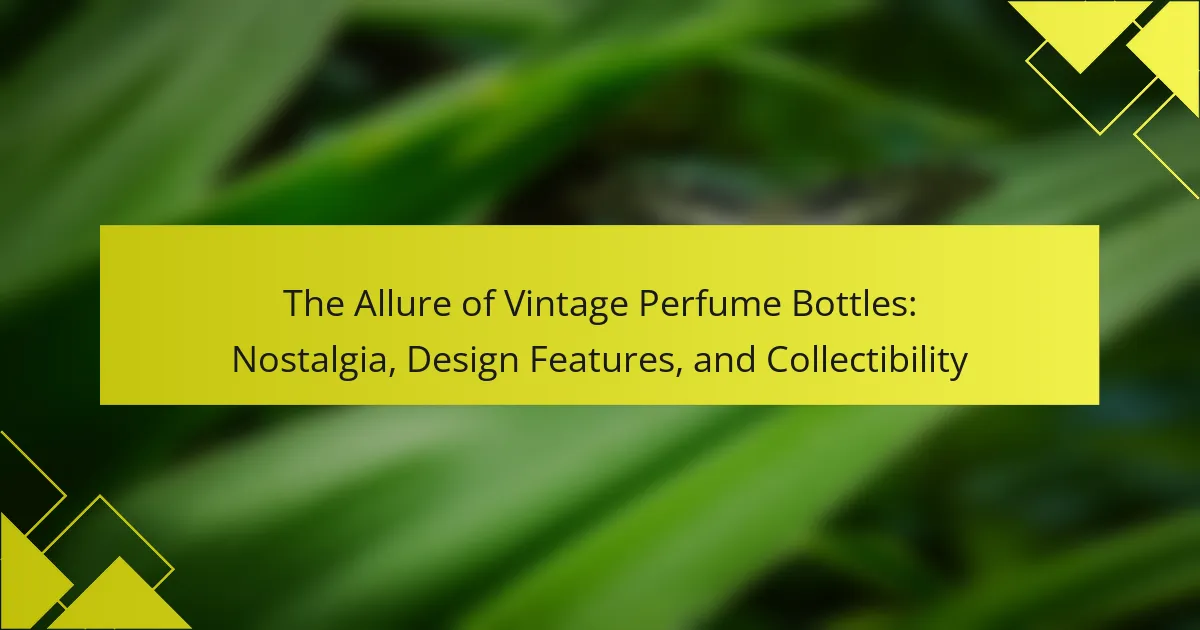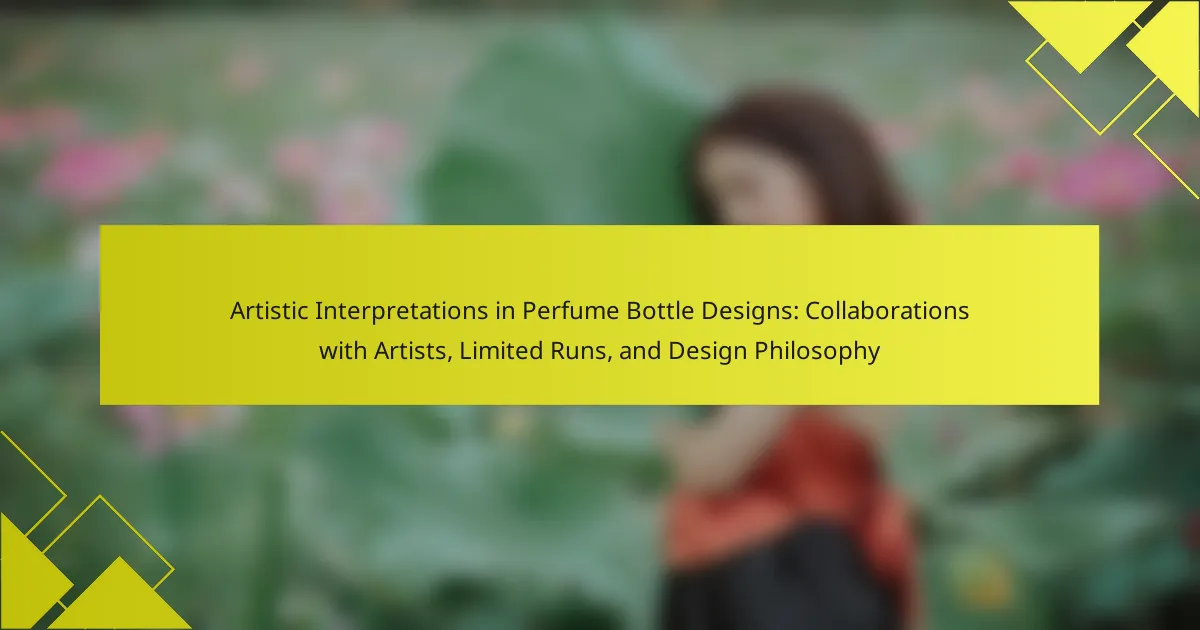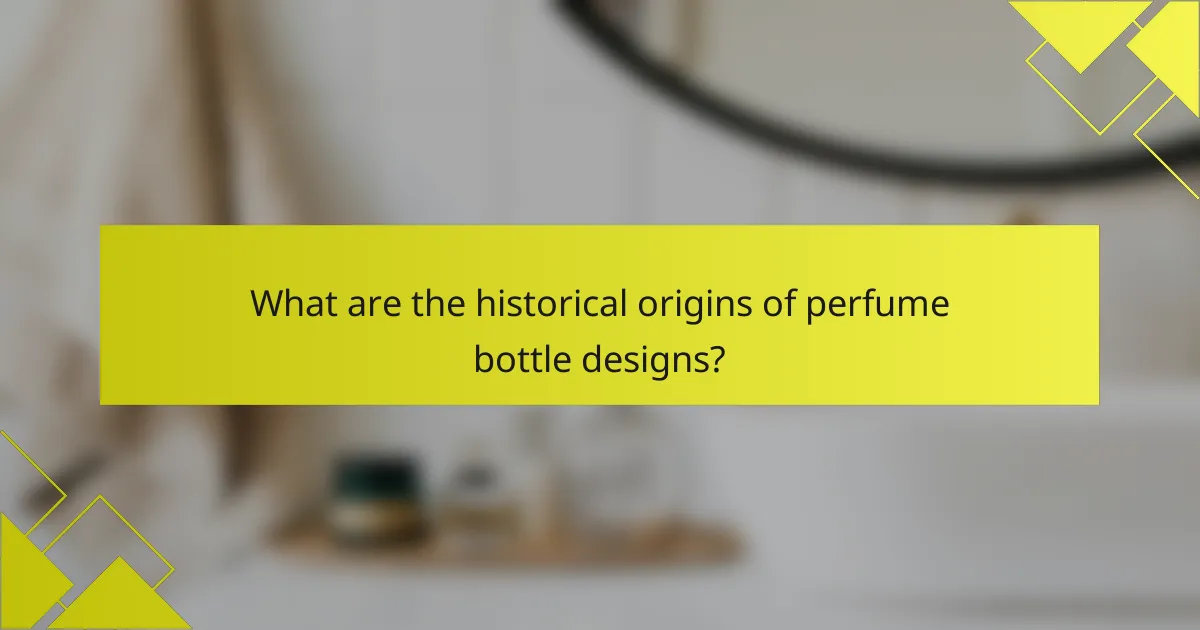
What are the historical origins of perfume bottle designs?
Perfume bottle designs originated in ancient civilizations. The earliest known perfume containers date back to around 3000 BC in ancient Egypt. These bottles were often made of alabaster or glass and featured intricate carvings. Perfume was a significant part of Egyptian culture, used in religious rituals and daily life.
In ancient Greece, perfume bottles, known as “alabastra,” were created from clay and glass. These designs were influenced by the Egyptians and were often decorated with elaborate motifs. The Romans further advanced perfume bottle design, using glassblowing techniques to create more complex shapes.
During the Middle Ages, perfume bottles became smaller and more ornate. They were often crafted from precious metals and stones, reflecting the wealth of their owners. The Renaissance period saw a revival of interest in perfume, leading to more innovative designs.
By the 17th century, perfume bottles began to resemble the modern designs we see today. They featured stoppers and were made from fine glass. The 19th century brought mass production, making perfume bottles more accessible.
Overall, the historical origins of perfume bottle designs showcase a blend of artistic expression and cultural significance throughout various eras.
How did ancient civilizations influence early perfume bottle designs?
Ancient civilizations significantly influenced early perfume bottle designs through their artistic and functional approaches. The Egyptians, for instance, created intricate glass and ceramic bottles to hold perfumes, often adorned with hieroglyphics and symbols. These designs reflected their beliefs in the spiritual significance of fragrances. In Mesopotamia, clay bottles were crafted with unique shapes, demonstrating a blend of utility and aesthetics. The Greeks and Romans further advanced bottle designs by introducing shapes inspired by nature, such as flowers and animals. Historical evidence shows that these civilizations valued the presentation of perfume, leading to elaborate decorations. This emphasis on artistry and symbolism laid the foundation for subsequent perfume bottle designs throughout history.
What materials were commonly used in ancient perfume bottles?
Ancient perfume bottles were commonly made from materials such as glass, clay, and metal. Glass was favored for its ability to create intricate designs. Clay was often used for its availability and ease of shaping. Metal, including bronze and gold, was valued for durability and aesthetic appeal. Many ancient cultures, including the Egyptians and Greeks, utilized these materials. Archaeological findings support this, with numerous examples of glass and clay bottles discovered in ancient burial sites.
How did the shapes of early perfume bottles reflect cultural beliefs?
Early perfume bottles reflected cultural beliefs through their designs and shapes. Many early bottles featured ornate and intricate designs, symbolizing luxury and status. The materials used, such as glass and crystal, indicated wealth and refinement. Shapes often mimicked natural forms, like flowers or animals, connecting to the belief in nature’s beauty and the divine. Bottles from different cultures showcased unique artistic styles, reflecting local traditions and aesthetics. For example, Egyptian bottles were often shaped like deities, highlighting spiritual significance. In contrast, European designs during the Renaissance emphasized symmetry and proportion, aligning with ideals of harmony and balance. These shapes served not just a functional purpose but also conveyed cultural values and social hierarchies.
What significant changes occurred in perfume bottle designs during the Renaissance?
During the Renaissance, perfume bottle designs underwent significant transformations. The period saw a shift from simple containers to more elaborate and artistic forms. Bottles began to feature intricate glasswork and ornate decorations. Artists and craftsmen employed techniques like engraving and painting on glass. The use of precious materials, such as gold and silver, became common in bottle designs. Additionally, the shapes of bottles diversified, including forms like animals and human figures. This era marked the beginning of perfume bottles being viewed as art objects, not just functional items. These changes reflected the broader cultural emphasis on beauty and craftsmanship during the Renaissance.
How did art and fashion trends impact perfume bottle aesthetics in this era?
Art and fashion trends significantly influenced perfume bottle aesthetics in this era. The Art Deco movement, prominent in the 1920s and 1930s, introduced geometric shapes and bold colors to bottle designs. This trend emphasized luxury and modernity, aligning with the fashion of the time that favored sleek silhouettes and opulent materials. Additionally, the rise of haute couture impacted bottle designs, as perfumers sought to reflect the elegance of the latest fashion trends. Designers collaborated with artists to create unique, collectible bottles that were seen as works of art. The use of innovative materials, such as crystal and metal, became popular, mirroring the fashion industry’s embrace of new textiles and finishes. Thus, the interplay between art, fashion, and perfume bottle design created a visually dynamic and culturally relevant aesthetic during this era.
What innovations in glassmaking contributed to new bottle designs?
Innovations in glassmaking have significantly influenced new bottle designs. The introduction of glassblowing techniques allowed for more intricate shapes and sizes. This technique became prominent in the first century BC. The development of mold-blowing further enabled mass production of uniform bottle designs. This innovation emerged in the 19th century. The use of colored glass became popular, allowing for aesthetic variety. This trend began in the 18th century and continues today. Advances in glass chemistry improved clarity and durability. These enhancements have been crucial for modern bottle designs.
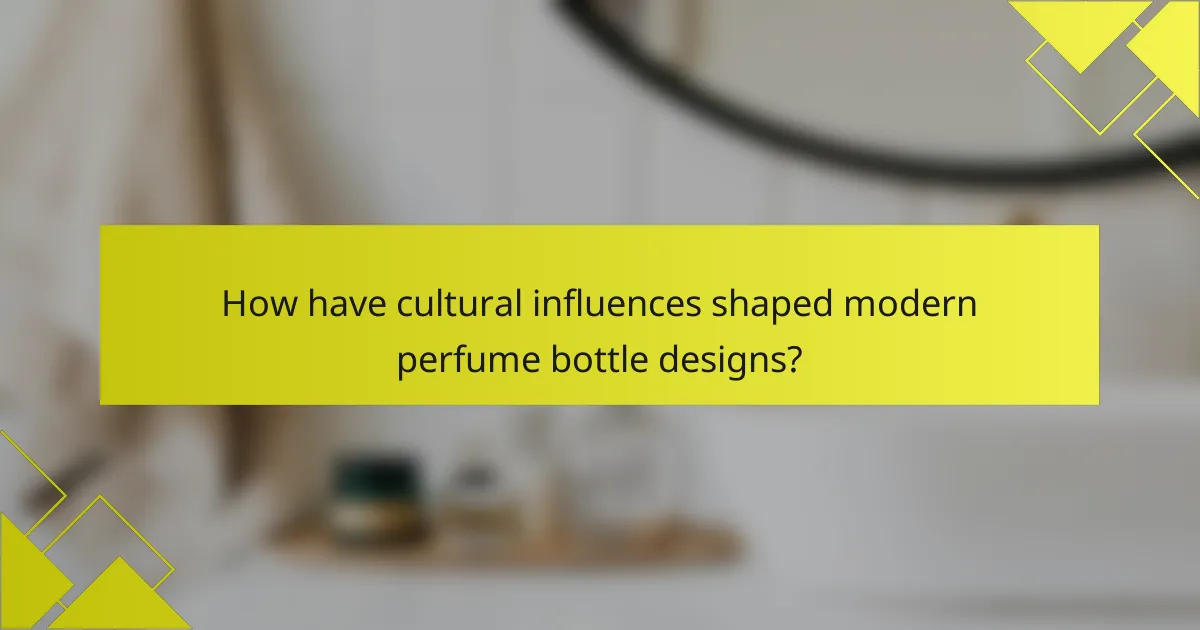
How have cultural influences shaped modern perfume bottle designs?
Cultural influences have significantly shaped modern perfume bottle designs through aesthetics and symbolism. Various cultures have contributed unique artistic styles and materials. For instance, Art Deco movements introduced geometric shapes and bold colors in the 1920s. Additionally, Eastern designs often incorporate natural elements and intricate detailing, reflecting cultural values.
The use of specific materials also varies by culture. For example, glass from Murano, Italy, is renowned for its craftsmanship and is often used in luxury bottles. Cultural symbolism is evident in designs that reflect local traditions and heritage.
In Japan, minimalist designs emphasize simplicity and elegance, aligning with the cultural principle of ‘wabi-sabi.’ Modern brands often pay homage to these cultural influences to create a connection with consumers. This blending of cultural elements enhances the storytelling aspect of perfume, making the bottles not just containers but also art pieces.
What role do cultural symbols play in contemporary perfume bottle aesthetics?
Cultural symbols significantly influence contemporary perfume bottle aesthetics. They enhance the visual appeal and convey deeper meanings. Many brands incorporate symbols that resonate with specific cultural narratives. For instance, motifs from nature or traditional art can reflect a brand’s heritage. This connection to culture can evoke emotions and memories in consumers. Additionally, cultural symbols can differentiate products in a competitive market. They help brands establish identity and authenticity. Iconic designs often draw on historical or mythological references. This practice creates a story that consumers can relate to. Overall, cultural symbols enrich the aesthetic experience of perfume bottles.
How do regional preferences affect the design of perfume bottles?
Regional preferences significantly influence the design of perfume bottles. Different cultures have unique aesthetic values and practical needs. In Asia, for example, minimalistic and sleek designs are favored, reflecting modernity and simplicity. Conversely, Middle Eastern markets often prefer ornate and intricate bottle designs, showcasing craftsmanship and luxury.
These regional aesthetics are rooted in cultural symbolism and consumer behavior. Research indicates that consumers in Europe lean towards classic and elegant shapes, while North American consumers often favor innovative and functional designs.
Market studies show that local traditions and customs also dictate bottle sizes and materials. For instance, glass is preferred in Western markets for its premium feel, whereas plastic may be more accepted in emerging markets for its affordability and durability.
Overall, regional preferences shape the visual and tactile experience of perfume bottles, aligning with consumers’ cultural identities and expectations.
What is the significance of branding in modern perfume bottle design?
Branding is crucial in modern perfume bottle design as it creates a distinct identity for the fragrance. A well-designed bottle reflects the brand’s values and appeals to target consumers. This visual representation influences purchasing decisions significantly. For instance, luxury brands often use intricate designs to convey exclusivity. Research indicates that 75% of consumers judge products by their packaging. Effective branding enhances recognition and loyalty in a competitive market. The aesthetics of the bottle can evoke emotions and associations linked to the fragrance. Thus, branding in perfume bottle design plays a vital role in marketing and consumer perception.
How have marketing strategies influenced the evolution of perfume bottle designs?
Marketing strategies have significantly influenced the evolution of perfume bottle designs. Initially, perfume bottles were functional and simple. As marketing became more prominent, brands began to focus on aesthetics. The design of bottles started to reflect the brand’s identity and target audience. Unique shapes and luxurious materials were introduced to attract consumers. For instance, the 1920s saw Art Deco influences, which emphasized glamour. In the modern era, eco-friendly designs have emerged due to sustainability marketing. This shift addresses consumer preferences for environmentally conscious products. Overall, marketing strategies have shaped not just the appearance but also the perceived value of perfume bottles.
What trends in consumer behavior have led to changes in bottle designs?
Sustainability trends have significantly influenced changes in bottle designs. Consumers increasingly prefer eco-friendly materials and designs. Brands are responding by using recycled and biodegradable materials. Minimalist designs are also trending due to consumer demand for simplicity and elegance. Personalization has become important, with consumers seeking unique and customizable options. Additionally, convenience features, like travel-friendly sizes, are gaining popularity. The rise of online shopping has led to designs that are visually appealing for digital marketing. These trends reflect a shift towards more responsible and consumer-centric bottle designs.
How do limited edition bottles create a sense of exclusivity?
Limited edition bottles create a sense of exclusivity by restricting availability. This scarcity enhances perceived value among consumers. When a product is available in limited quantities, it becomes more desirable. Collectors often seek out these unique items to differentiate their collections. Brands may also use distinctive designs or packaging for these editions. For instance, a brand might incorporate rare materials or artistic elements. This uniqueness further elevates the product’s status. Marketing strategies often emphasize the rarity and special nature of these bottles, reinforcing their exclusivity.
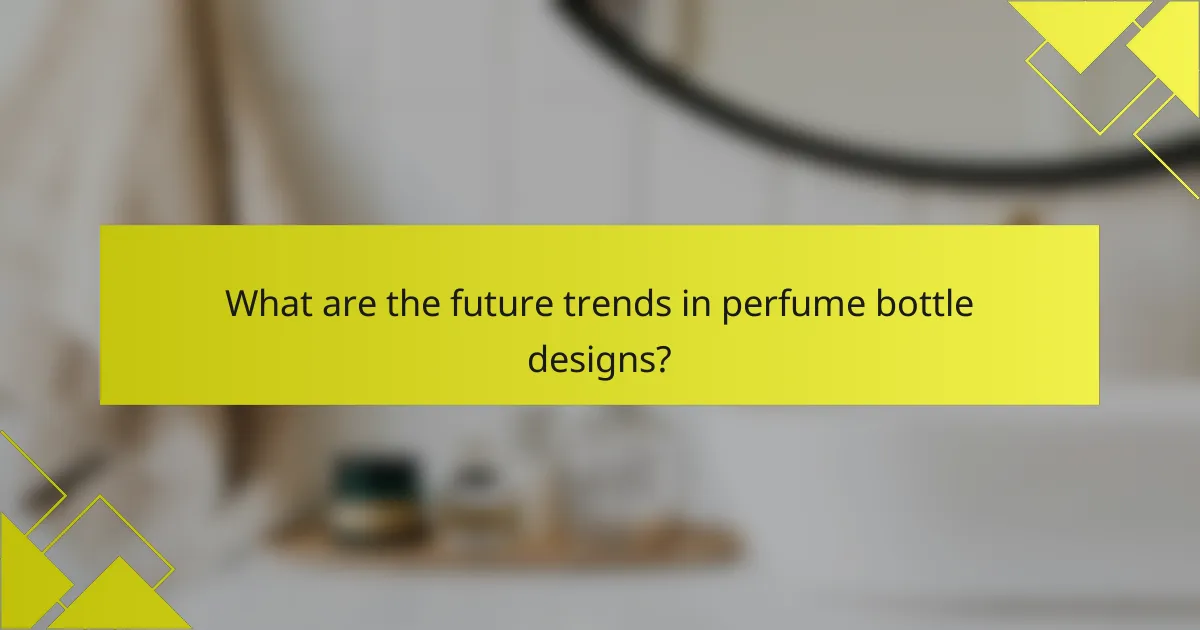
What are the future trends in perfume bottle designs?
Future trends in perfume bottle designs emphasize sustainability and minimalism. Eco-friendly materials will become increasingly popular. Brands are likely to adopt refillable and reusable bottle designs. This shift is driven by consumer demand for environmentally responsible products. Additionally, innovative shapes and artistic designs will gain traction. Customization options may allow consumers to personalize their bottles. Technology integration, such as smart features, could enhance user experience. Overall, these trends reflect a blend of aesthetics and functionality in perfume bottle design.
How is sustainability impacting the design of perfume bottles?
Sustainability is significantly influencing the design of perfume bottles. Designers are increasingly opting for eco-friendly materials. This includes using recycled glass and biodegradable plastics. Many brands are also minimizing packaging to reduce waste. Refillable bottles are becoming more popular among consumers. This trend helps to decrease single-use plastic waste. Additionally, brands are focusing on energy-efficient production methods. According to a 2021 report by the Fragrance Foundation, sustainable packaging is a top priority for 70% of fragrance companies. These changes reflect a broader commitment to environmental responsibility in the beauty industry.
What materials are emerging as eco-friendly alternatives for bottle production?
Biodegradable plastics, glass, and plant-based materials are emerging as eco-friendly alternatives for bottle production. Biodegradable plastics break down more easily in the environment compared to traditional plastics. Glass is recyclable and can be reused multiple times without losing quality. Plant-based materials, such as those derived from sugarcane, offer a sustainable option with a lower carbon footprint. These materials help reduce reliance on fossil fuels and minimize environmental impact. Research indicates that using these alternatives can significantly decrease plastic waste. For instance, the use of biodegradable plastics can reduce plastic pollution in oceans and landfills.
How are brands innovating to reduce waste in packaging?
Brands are innovating to reduce waste in packaging by adopting sustainable materials and designs. Many companies are using biodegradable or recyclable materials for their packaging. This shift minimizes environmental impact and promotes circular economy practices. Additionally, brands are implementing refillable packaging systems. These systems encourage consumers to reuse containers, significantly reducing single-use waste. Some brands are also optimizing their packaging sizes to decrease material usage. For example, smaller packages require less material and generate less waste. Research shows that sustainable packaging can enhance brand loyalty, with 73% of consumers willing to pay more for eco-friendly options. Overall, these innovations reflect a growing commitment to sustainability in the packaging industry.
What technological advancements are shaping the future of perfume bottle designs?
Technological advancements significantly influence the future of perfume bottle designs. Innovations in materials, such as biodegradable plastics and recycled glass, enhance sustainability. Smart technology integration allows for personalized fragrance experiences. 3D printing enables unique and customizable bottle shapes. Advances in atomization technology improve fragrance delivery and reduce waste. Digital printing techniques allow for intricate designs and branding options. These advancements reflect a growing focus on sustainability and consumer engagement in the fragrance industry.
How is 3D printing influencing the customization of perfume bottles?
3D printing is revolutionizing the customization of perfume bottles. It allows for unique designs tailored to individual preferences. Brands can create intricate shapes that were previously difficult to manufacture. This technology reduces production time and costs for custom designs. Additionally, 3D printing enables rapid prototyping, allowing brands to test new concepts quickly. The ability to personalize bottles enhances consumer engagement and brand loyalty. According to a study by Wohlers Associates, the 3D printing industry is expected to grow to $35.6 billion by 2024, indicating significant investment in customization technologies.
What role does smart technology play in the evolution of fragrance packaging?
Smart technology enhances fragrance packaging by integrating digital features. These features include NFC tags and QR codes for interactive consumer experiences. Smart packaging allows brands to provide detailed product information and authenticity verification. It also facilitates personalized marketing through user engagement. A study by Smithers Pira indicates that smart packaging can increase consumer interaction by 25%. Smart technology also supports sustainability efforts by tracking product lifecycle and reducing waste. Overall, it revolutionizes how consumers connect with fragrance products.
What practical tips can consumers consider when choosing perfume bottles?
Consider the material of the perfume bottle. Glass is preferred for its non-reactive properties. Check the bottle design for ease of use. A spray nozzle is often more convenient than a splash top. Evaluate the size of the bottle. Smaller bottles are portable, while larger ones offer more value. Look for a secure cap to prevent leakage. Examine the aesthetics of the bottle. A visually appealing design can enhance the experience. Consider the brand reputation for quality. Established brands often ensure better craftsmanship and materials. Lastly, check for refill options. Refillable bottles are eco-friendly and cost-effective.
The main entity of the article is perfume bottle designs, which have evolved significantly from ancient civilizations to modern times. The article explores the historical origins of these designs, tracing their development from ancient Egypt to the Renaissance, and examines the cultural influences that shaped their aesthetics. It also highlights the impact of marketing strategies and consumer behavior on contemporary designs, including trends toward sustainability and personalization. Additionally, the article discusses future trends such as technological advancements and eco-friendly materials that are likely to shape the next generation of perfume bottles.
